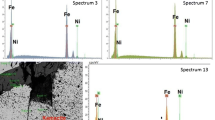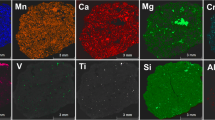Abstract
A piece of rock belonging to the geological-mineralogical collection of the University of Antioquia, with a metallic aspect and labelled as “meteorite originating from Devil’s Canyon (USA)” was subject to several spectroscopic analysis in order to confirm that it was a meteorite. X-ray fluorescence spectroscopy (XRF) shows that Fe and Ni are present in significant amount. The elemental composition showed the rock to contain 90.63% Fe and 7.35% Ni. The remaining 2% of elements were found to be: Si, Co, P, Al and W. The X-ray diffraction (XRD) shows that the major mineralogical phase corresponds to α-Fe. Mössbauer spectroscopy (MS) measurements at room temperature indicated three iron sites present: Fe3+, and the others two corresponding to sextets that could be assigned to either kamacite or taenite. The inner surface was analysed using AFM (Atomic Force Microscopy). The topography of selected areas shows roughness values range from 2.99 to 86.80 nm. Finally, the metallographic images of the microstructure of the material were compared with those obtained in 2001 and it was possible to verify and conclude that the rock effectively corresponds to a meteorite.






Similar content being viewed by others
Data availability
No datasets were generated or analysed during the current study.
References
Marzari, F., et al.: In: Asteroids, W.F. III, Bottke, A. Jr., Cellino, P., Paolicchi, Binzel, R.P. (eds.) Origins and Evolution of Trojan Asteroids, pp. 725–738. University of Arizona, Tucson (2002)
Bennett, J.O., et al.: The Cosmic Perspective (7th Edition) Pearson; (2013)
Barringer D.M.: Coon Mountain and its Crater. Proc. Acad. Nat. Sci. Phila. 57, 861–886 (1906)
Goldstein, J.I., Short, J.M.: The iron meteorites, their thermal history and parent bodies. Geochim. Cosmochim. Acta. 31, 1733–1770 (1967)
Comelli, D., et al.: The meteoritic origin of Tutankhamun’s iron dagger blade. Meteorit. Planet. Sci. 51, 1301–1309 (2016)
Ridpath, I.A.: Dictionary of Astronomy, 2 edn. Oxford University Press (2012)
Bischoff, A.: Meteorite classification and the denition of new chondrite classes as a result of successful meteorite searching hot and cold deserts. Planet. Space Sci. 49, 769–776 (2001)
Weisberg, M.K., et al.: Systematics and Evaluation of Meteorite Classification in Meteorites and the Early Solar System II, pp. 19–52. Univ. of Arizona (2006)
Voort, V., George, F.: A note on metallographics techniques for iron meteorites. Mater. Characterizations. 29, 223–241 (1992)
Lutterotti, L.: Total pattern fitting for the combined size-strain-stress-texture determination in thin film diffraction. Nuclear Inst. Methods Phys. Res. B. 268, 334–340 (2010)
Tañeza-Casco, F., et al.: Combined elemental xrf and phase xrd analyses of a meteorite. Advances in X-ray analysis, 59, 85–97 (2016)
Lagarec, K., Rancourt, D.G.: RECOIL 1.05. Mossbauer Spectral Analysis Software for Windows. University of Ottawa (1998)
Galazka-Friedman, J., et al.: Mössbauer spectroscopy—a useful method for classification of meteorites. Hyperfine Interact. 238, 67 (2017)
Munayco, P., et al.: The new Peruvian Meteorite carancas: Mössbauer Spectroscopy and X-Ray Diffraction studies. Earth Moon Planet. 110, 1–9 (2013)
Ouseph, P.J., et al.: Mössbauer spectra for iron bearing phases in meteorite Toluca. Meteoritics. 14, 97–108 (1979)
Cerón, M.L., et al.: Magnetic properties of the Tuxtuac Meteorite via 57Fe Mössbauer Spectroscopy. Revista De Investigación De Física. 22(1), 3–7 (2019)
Albertsen, J.F., et al.: Mossbauer Effect studies of Taenite Lamellae of an Iron Meteorite Cape York (Ill. A). Phys. Scr. 17, 467–472 (1978)
Sitek, J., et al.: Analysis of Kosice meteorite by Mossbauer spectroscopy. J. Electr. Eng. 67, 307–310 (2016)
Mössbauer, M., Stevens, H., Khasanov, A.M., Miller, J.W., Pollak, H., Li, Z. (eds.): Mössbauer Effect Data Center, (2002)
Voort, V., George, F.: Metallography of iron Meteorites. Advanced materials & processes, February (2001)
Gałazka-Friedman, J., et al.: Mossbauer studies of Soltmany and Shisr 176 meteorites – comparison with other ordinary chondrites. Hyperfine Interact. 226, 593–600 (2014)
Paduani, C., et al.: A Mossbauer effect study of the Soledade Meteorite. Brazilian Journal of Physics, 35(3A), September, (2005)
Vdovykin, G.P.: The canyon Diablo meteorite. Space Sci. Rev. 14, 758–831 (1973)
Rubin, A.E.: Mineralogy of meteorite groups. Meteoritics B Planet. Sci. 32, 23, 1–247 (1997)
Acknowledgements
The authors are deeply grateful to Mr. Melvin James Godoy from the National University of San Marcos, Peru, for his help AFM measurements.
Author information
Authors and Affiliations
Contributions
J.F.S. performed the EDXRF and WDXRF measurements and analysis, and the preparation of the samples for the diffraction and Mössbauer measurements.C.B.M. performed the measurement by Mössbauer Spectroscopy and the respective analysis of the spectrum obtained.J.R.C. performed sample preparation and metallographic analysis.W. B. performed the sample preparation and metallographic analysis.J.C.G. prepared the sample and performed the measurement by AFM.S.E. carried out the x-ray diffraction analysis.The article was reviewed by all authors.
Corresponding author
Ethics declarations
Competing interests
The authors declare no competing interests.
Additional information
Publisher’s Note
Springer Nature remains neutral with regard to jurisdictional claims in published maps and institutional affiliations.
Rights and permissions
Springer Nature or its licensor (e.g. a society or other partner) holds exclusive rights to this article under a publishing agreement with the author(s) or other rightsholder(s); author self-archiving of the accepted manuscript version of this article is solely governed by the terms of such publishing agreement and applicable law.
About this article
Cite this article
Fabián-Salvador, J., M, C.B., C, J.R. et al. Mineralogical composition, surface inspection and analysis by Mössbauer spectroscopy to identify a meteorite. Hyperfine Interact 245, 44 (2024). https://doi.org/10.1007/s10751-024-01873-6
Accepted:
Published:
DOI: https://doi.org/10.1007/s10751-024-01873-6




